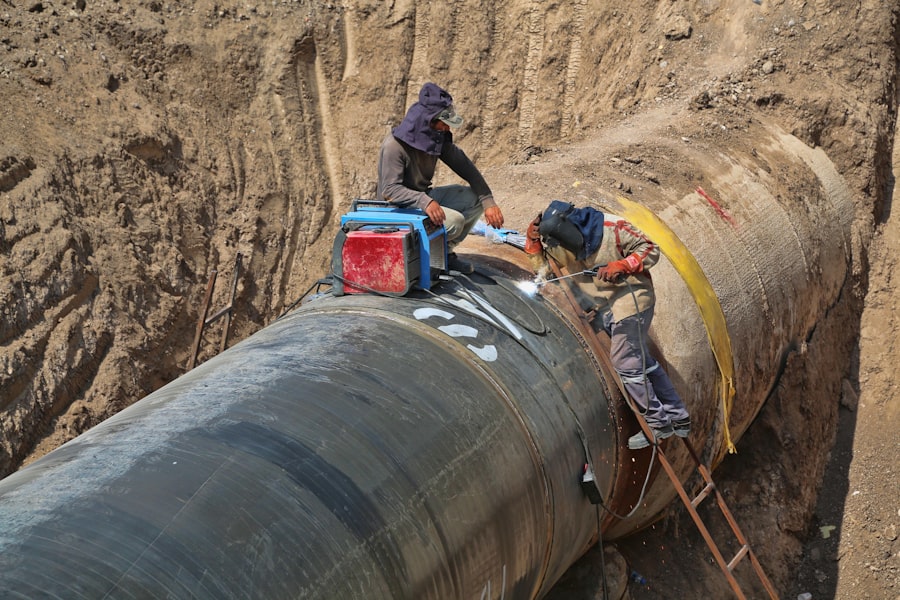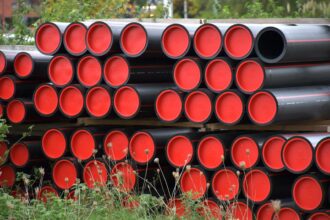Pipeline maintenance logs serve as critical documentation that ensures the integrity and safety of pipeline systems. These logs provide a detailed account of all maintenance activities, inspections, and repairs conducted on pipelines, which are essential for preventing leaks, ruptures, and other hazardous incidents. By maintaining accurate and comprehensive records, organizations can track the history of their pipelines, identify trends over time, and make informed decisions regarding future maintenance needs.
The importance of these logs cannot be overstated; they are not only vital for regulatory compliance but also play a significant role in risk management and operational efficiency. Moreover, maintenance logs facilitate communication among various stakeholders involved in pipeline operations. Engineers, technicians, and management can refer to these logs to understand past issues and the effectiveness of previous interventions.
This shared knowledge base fosters a culture of transparency and accountability within the organization. When everyone is aware of the pipeline’s maintenance history, it becomes easier to coordinate efforts and prioritize tasks effectively. In essence, pipeline maintenance logs are indispensable tools that contribute to the overall reliability and safety of pipeline infrastructure.
Key Takeaways
- Proper maintenance logs are crucial for the efficient operation and safety of pipelines.
- A comprehensive template for maintenance logs should include all relevant information and be easy to use.
- Personnel should be trained on proper logging procedures to ensure accuracy and consistency.
- Implementing a regular schedule for maintenance log updates helps to keep records current and reliable.
- Utilizing digital tools can streamline the logging process and improve efficiency.
Creating a Comprehensive Template for Maintenance Logs
Developing a comprehensive template for maintenance logs is a foundational step in ensuring that all necessary information is captured consistently. A well-structured template should include essential fields such as date, time, location, type of maintenance performed, personnel involved, and any observations made during the process. Additionally, it should allow for the documentation of materials used, equipment status, and any follow-up actions required.
By standardizing the format of maintenance logs, organizations can streamline data entry and enhance the clarity of information recorded. Incorporating sections for both routine and emergency maintenance activities is also crucial. Routine maintenance logs can help track scheduled inspections and preventive measures, while emergency logs can document unexpected repairs or incidents.
This dual approach ensures that all aspects of pipeline maintenance are covered comprehensively. Furthermore, organizations may consider integrating visual aids such as diagrams or photographs to enhance understanding and provide context for specific maintenance activities. A well-designed template not only simplifies the logging process but also enhances the utility of the data collected.
Training Personnel on Proper Logging Procedures

Training personnel on proper logging procedures is essential for ensuring that maintenance logs are filled out accurately and consistently. Employees must understand the significance of these logs and how they contribute to the overall safety and efficiency of pipeline operations. Training sessions should cover the specific requirements of the logging process, including how to use the template effectively and what information needs to be recorded.
By providing hands-on training and real-life examples, organizations can reinforce the importance of meticulous record-keeping. Additionally, ongoing training should be implemented to keep personnel updated on any changes in logging procedures or technology. As new tools and methods emerge, it is vital that employees are equipped with the knowledge to adapt to these advancements.
Regular refresher courses can help maintain a high standard of logging practices across the organization. By investing in training, companies not only enhance the quality of their maintenance logs but also empower their workforce to take ownership of their responsibilities.
Implementing a Regular Schedule for Maintenance Log Updates
| Metrics | Value |
|---|---|
| Number of maintenance log updates per week | 25 |
| Percentage of completed maintenance tasks | 95% |
| Average time taken to update maintenance logs | 10 minutes |
| Number of overdue maintenance tasks | 3 |
Establishing a regular schedule for updating maintenance logs is crucial for maintaining accurate records over time. Organizations should determine how frequently logs need to be updated based on their specific operational needs and regulatory requirements. For instance, some companies may opt for daily updates following routine inspections, while others may choose weekly or monthly intervals for more comprehensive reviews.
Regardless of the chosen frequency, consistency is key to ensuring that all relevant information is captured in a timely manner. In addition to regular updates, organizations should also implement a system for reviewing and validating the information recorded in maintenance logs. This could involve periodic audits where designated personnel assess the accuracy and completeness of the logs.
By creating a structured schedule for both updates and reviews, organizations can ensure that their maintenance records remain reliable and useful for decision-making processes.
Utilizing Digital Tools for Efficient Logging
The advent of digital tools has revolutionized the way organizations manage their maintenance logs. Utilizing software applications designed specifically for logging purposes can significantly enhance efficiency and accuracy. Digital tools often come equipped with features such as automated data entry, real-time updates, and cloud storage capabilities, which streamline the logging process and reduce the risk of human error.
Furthermore, these tools can facilitate easier access to historical data, allowing personnel to quickly retrieve information when needed. In addition to improving efficiency, digital logging solutions can also enhance collaboration among team members. Many software platforms allow multiple users to access and update logs simultaneously, fostering a more integrated approach to pipeline maintenance.
This collaborative environment encourages communication and ensures that everyone involved in pipeline operations is on the same page regarding maintenance activities. By embracing digital tools, organizations can modernize their logging practices and improve overall operational effectiveness.
Analyzing and Interpreting Maintenance Log Data

Once maintenance logs have been compiled, analyzing and interpreting the data becomes essential for deriving actionable insights. Organizations should establish key performance indicators (KPIs) that align with their operational goals to evaluate the effectiveness of their maintenance efforts. For instance, tracking metrics such as response times to issues or the frequency of specific types of repairs can provide valuable insights into areas that may require improvement.
Data analysis can also reveal trends over time that may not be immediately apparent from individual log entries. For example, if multiple entries indicate recurring issues with a particular section of pipeline, this could signal an underlying problem that needs to be addressed proactively. By leveraging data analytics tools, organizations can transform raw log data into meaningful information that informs strategic decision-making and enhances overall pipeline management.
Identifying Common Issues and Patterns in Maintenance Logs
Through diligent analysis of maintenance log data, organizations can identify common issues and patterns that may arise within their pipeline systems. Recognizing these recurring problems allows companies to take a proactive approach to maintenance rather than merely reacting to incidents as they occur. For instance, if a specific type of valve consistently requires repairs across multiple logs, it may indicate a design flaw or inadequate installation practices that need to be addressed.
Additionally, identifying patterns in maintenance activities can help organizations allocate resources more effectively. If certain times of year see an uptick in repairs or inspections due to environmental factors or operational demands, companies can plan accordingly by scheduling additional personnel or resources during those peak periods. By understanding common issues and patterns within their maintenance logs, organizations can enhance their overall operational resilience.
Developing Action Plans Based on Maintenance Log Findings
Once common issues have been identified through log analysis, developing action plans becomes imperative for addressing these challenges effectively. Action plans should outline specific steps that need to be taken to rectify identified problems, including timelines for implementation and designated personnel responsible for each task. By creating structured action plans based on concrete data from maintenance logs, organizations can ensure that they are taking informed steps toward improving their pipeline systems.
Furthermore, action plans should incorporate mechanisms for monitoring progress and evaluating outcomes. This could involve setting up follow-up inspections or additional logging requirements to assess whether implemented changes have had the desired effect. By continuously refining action plans based on ongoing analysis of maintenance log data, organizations can foster a culture of continuous improvement that enhances both safety and efficiency.
Collaborating with Other Departments for Holistic Maintenance Approaches
Collaboration among different departments is essential for developing holistic approaches to pipeline maintenance. Maintenance teams should work closely with engineering, operations, safety, and environmental departments to ensure that all aspects of pipeline management are considered in decision-making processes. By fostering interdepartmental communication and collaboration, organizations can create comprehensive strategies that address not only immediate maintenance needs but also long-term operational goals.
For instance, insights from engineering teams regarding design improvements can inform maintenance practices by reducing the likelihood of recurring issues. Similarly, safety departments can provide valuable input on best practices for conducting inspections or repairs in compliance with regulatory standards. By leveraging expertise from various departments, organizations can develop more effective maintenance strategies that enhance overall pipeline performance.
Conducting Regular Audits and Reviews of Maintenance Logs
Regular audits and reviews of maintenance logs are critical for ensuring compliance with industry standards and internal policies. These audits serve as an opportunity to assess the accuracy and completeness of logged information while identifying any discrepancies or areas for improvement. Organizations should establish a routine schedule for conducting these audits—whether quarterly or annually—to maintain high standards in record-keeping practices.
During audits, it is essential to involve personnel who are familiar with both the logging process and the technical aspects of pipeline operations. Their insights can help identify potential gaps in documentation or areas where additional training may be needed. By conducting thorough audits and reviews regularly, organizations can reinforce accountability within their teams while ensuring that maintenance logs remain reliable sources of information.
Continuously Improving and Updating Maintenance Log Processes
The landscape of pipeline management is constantly evolving due to advancements in technology, regulatory changes, and emerging best practices. As such, organizations must commit to continuously improving and updating their maintenance log processes to stay ahead of these developments. This could involve revisiting templates periodically to incorporate new fields or features based on user feedback or industry trends.
By fostering a culture of continuous improvement within their logging processes, organizations can ensure that they remain agile in responding to changing circumstances while maintaining high standards in pipeline safety and efficiency. In conclusion, effective pipeline maintenance logging is an integral component of successful pipeline management strategies.
By understanding its importance, creating comprehensive templates, training personnel adequately, implementing regular updates, utilizing digital tools, analyzing data effectively, identifying common issues, developing action plans collaboratively with other departments, conducting audits regularly, and committing to continuous improvement—organizations can significantly enhance their operational resilience while ensuring compliance with industry standards.
If you’re interested in understanding the intricacies of pipeline maintenance logs, you might also find it beneficial to explore related resources that provide a broader context on the subject. For instance, the article available at In The War Room offers insights into various aspects of maintenance and operational strategies. This resource can serve as a complementary guide, enhancing your comprehension of how maintenance logs fit into the larger framework of pipeline management and operational efficiency.
WATCH THIS! The FSB’s Hidden War on Europe’s Pipelines
FAQs
What is a pipeline maintenance log?
A pipeline maintenance log is a record of all maintenance activities and inspections performed on a pipeline system. It includes details such as the date of maintenance, type of maintenance performed, any issues found, and the actions taken to address them.
Why is it important to read a pipeline maintenance log?
Reading a pipeline maintenance log is important to understand the history of maintenance activities on the pipeline system. It helps in identifying any recurring issues, tracking the performance of the pipeline, and ensuring compliance with regulatory requirements.
What information can be found in a pipeline maintenance log?
A pipeline maintenance log typically includes information about routine maintenance, repairs, inspections, testing, and any incidents or abnormalities encountered during the operation of the pipeline. It may also contain details about the personnel involved in the maintenance activities and the equipment used.
How can one interpret a pipeline maintenance log?
Interpreting a pipeline maintenance log involves understanding the terminology used, identifying patterns or trends in maintenance activities, and recognizing any recurring issues or areas of concern. It may also involve correlating the information in the log with the overall performance of the pipeline system.
Who typically reads a pipeline maintenance log?
Pipeline operators, maintenance personnel, regulatory agencies, and other stakeholders involved in the operation and maintenance of the pipeline system typically read and interpret pipeline maintenance logs. It is an essential part of ensuring the integrity and safety of the pipeline.




